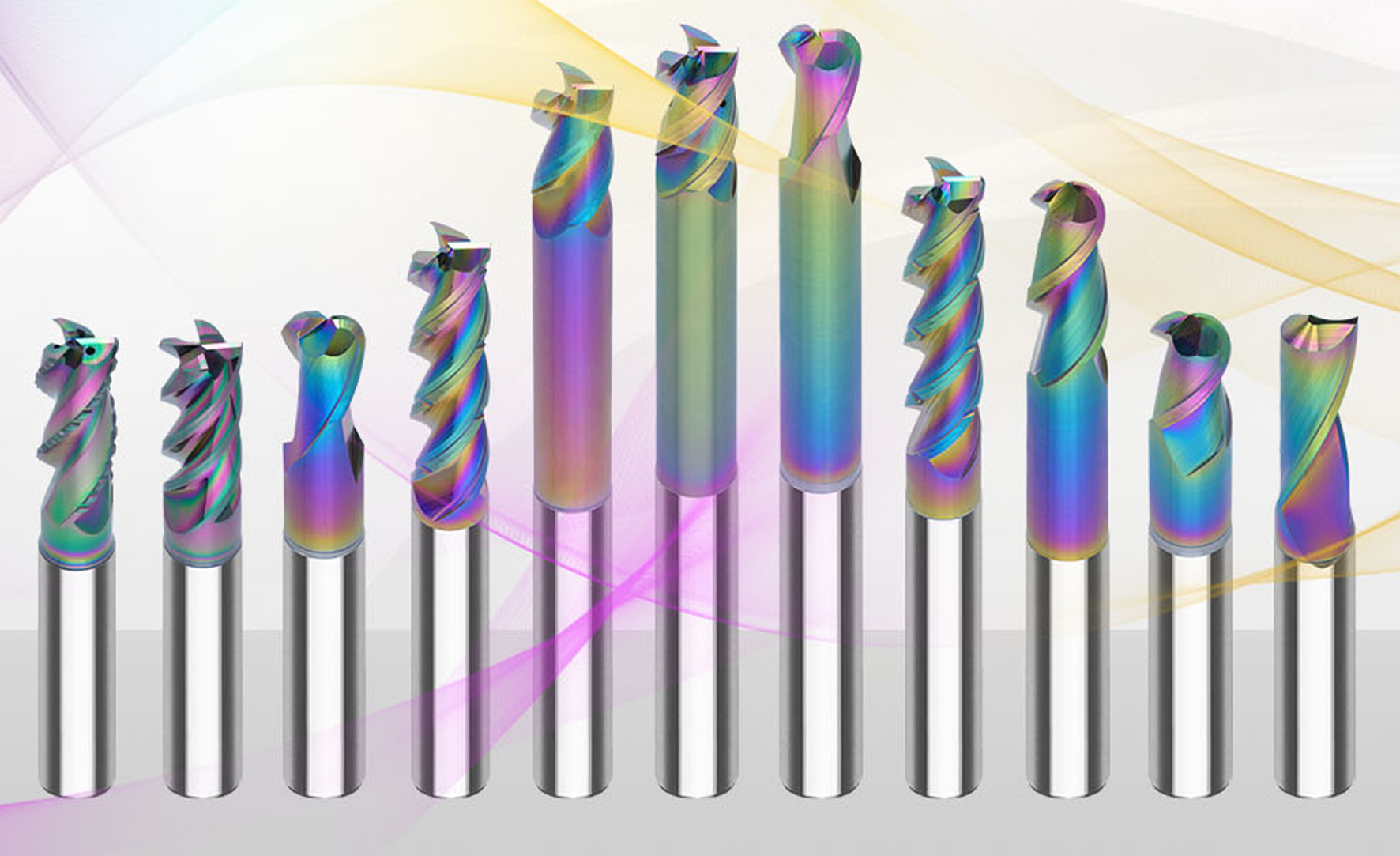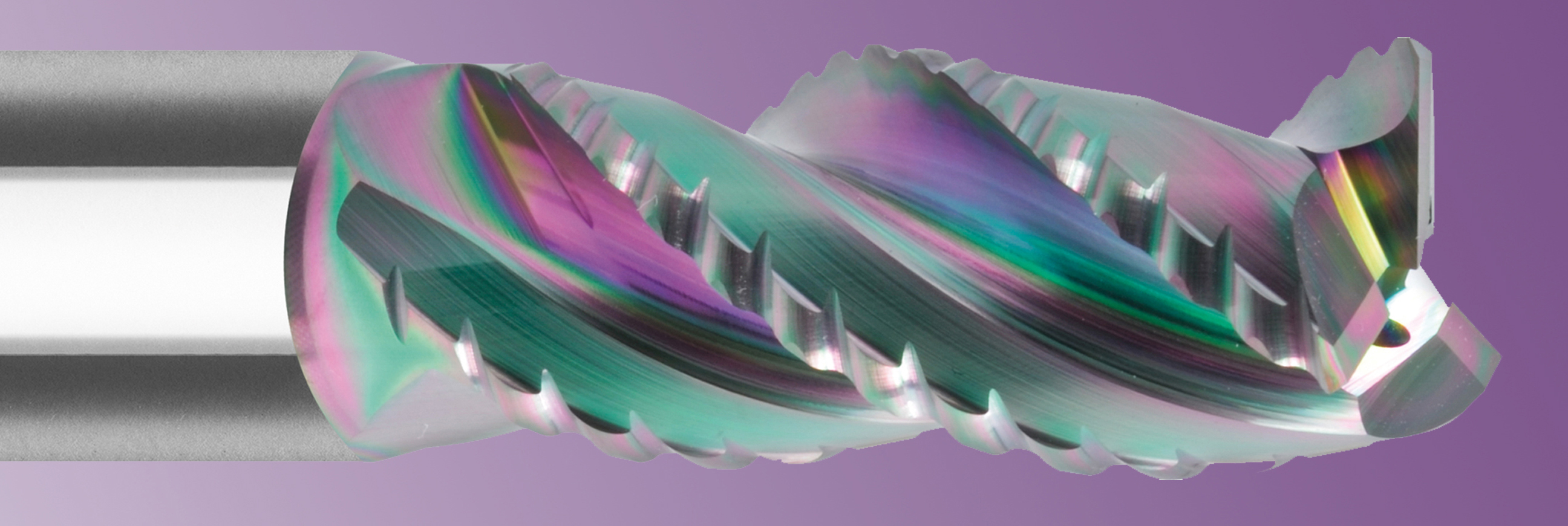 A new line of aluminum tools from Inovatools utilizes the ta-C thin-layered coating that the company says makes the process of machining aluminum and its alloys more productive and cost-effective.
A new line of aluminum tools from Inovatools utilizes the ta-C thin-layered coating that the company says makes the process of machining aluminum and its alloys more productive and cost-effective.
Inovatools USA LLC, a Germany-based company with U.S. offices in Hartland, Michigan, released its VHM line of aluminum tools that feature an amorphous, hydrogen-rich ta-C carbon high-performance thin-layered coating that has a microhardness of 6,000 to 7,500 HV. It is a wear-resistant variant of diamond-like carbon (DLC) coatings that allows for efficient machining of challenging materials such as aluminum with a maximum silicon content of 10%, copper materials, graphite, glass-fiber-reinforced plastic (GFRP) and carbon-fiber-reinforced plastic (CFRP).
The coating has excellent sliding properties, and its coating hardness amounts to roughly 60% to 80% of the hardness of a diamond coating, the company says.
It is wear-resistant and low-friction in both lubricated and unlubricated applications. The coating is applied at less than 250°, which means that even temperature-resistant substrates can be coated without the geometry changing. It can be applied thinly enough to prevent the rounding of sharp cutting edges.
In a comparative test involving machining an aluminum section made from AlMg0, 7Si (diameter: 16 mm, Z = 3, type W, helix angle = 20°, polished chip groove, service life criterion = burr formation), and a ZrN-coated mill (2,000 HV) managed 2,000 acceptable parts. A mill from the Inovatools ta-C tool range (6,000 to 7,00 HV) achieved 10,000 acceptable parts.
Tools for every application
The mills from the new Inovatools ta-C range for aluminum machining are ideally matched to their applications and milling strategies in terms of substrate, geometry and coating. The line-up includes single- and multi-edged tools for roughing and finishing, long and short versions, variations with corner radius and full radius, for standard use and for HPC, HSC and trochoidal (TSC) applications.
One exa mple from the ta-C series is the Primus HPC aluminum roughing end mill. With internal cooling and multi-turning, the Primus is equipped to deliver consistently quiet, low-vibration, energy-efficient performance at extremely high-feed rates. The tool has a special knurled section with optimized chip control as well as the ta-C coating that enables it to eliminate the usual problems in cutting aluminum such as high adhesion tendency with built-up edges, welding deposits, chip caking, and burr formation.
mple from the ta-C series is the Primus HPC aluminum roughing end mill. With internal cooling and multi-turning, the Primus is equipped to deliver consistently quiet, low-vibration, energy-efficient performance at extremely high-feed rates. The tool has a special knurled section with optimized chip control as well as the ta-C coating that enables it to eliminate the usual problems in cutting aluminum such as high adhesion tendency with built-up edges, welding deposits, chip caking, and burr formation.
The coating, combined with its microgeometry in conjunction with the cutting-edge preparation, make the tool highly resilient. This prevents micro-chipping and makes the cutting edges more resilient. This “defect-free cutting-edge design” considerably increases the service life of the Primus. This is supported by the entwined profile’s special chip separators. They break the aluminum chips quickly and at an early stage, and, thanks to large chip grooves, can be rapidly transported away from the engagement zone with cutting fluid. Not only does this bring a high level of process security, it also ensures low-vibration running for high-surface quality, even during HPC roughing. This means that Primus tools operate with minimal vibrations even at exceptionally high feed rates; for example, during the machining of aluminum for airplanes.
The three-edged Primus is available in diameter ranges from 6.00 mm to 20.00 mm, with internal cooling, multi-turning and straight and Weldon shank designs.
During a customer test in cutting aluminum 3.2315 (AlMgSi1/AlSiMgMn), the Primus proved up to 30% more cutting capacity than previous tooling options. With cutting data of D1 = 20 mm, ae/ap = 1xD, vc = 750 m/min, fz = 0.3 mm, the Primus achieved a cutting volume of 4,297 cm3/min compared with the 3,008 cm3/min of the reference tool.
 In addition to the ta-C series, the company recommends other mills and drills including the CurveMax CSC (curve segment cutter) with a ta-C coating for aluminum structural components or copying applications, such as in the aerospace industry. The CurveMax mills’ special geometries permit bigger path distances and line jumps during pre-finishing and finishing. Although the working radius is larger than that of a traditional full-radius mill, the tool still has the same diameter.
In addition to the ta-C series, the company recommends other mills and drills including the CurveMax CSC (curve segment cutter) with a ta-C coating for aluminum structural components or copying applications, such as in the aerospace industry. The CurveMax mills’ special geometries permit bigger path distances and line jumps during pre-finishing and finishing. Although the working radius is larger than that of a traditional full-radius mill, the tool still has the same diameter.
“Extreme feed rates, more cutting volume – tools from Inovatools for machining aluminum and its alloys show that it is possible to employ optimizations to aspects of design such as microgeometry, chip control, grinding and high-performance coatings to take aluminum machining to a whole new level of performance,” said Nilüfer Cebic, head of product management and marketing at Inovatools.
Related Glossary Terms
- Vickers hardness number ( HV)
Vickers hardness number ( HV)
Number related to the applied load and surface area of the permanent impression made by a square-based pyramidal diamond indenter having included face angles of 136º. The Vickers hardness number is a ratio of the applied load in kgf, multiplied by 1.8544, and divided by the length of diagonal squared.
- alloys
alloys
Substances having metallic properties and being composed of two or more chemical elements of which at least one is a metal.
- amorphous
amorphous
Not having a crystal structure; noncrystalline.
- burr
burr
Stringy portions of material formed on workpiece edges during machining. Often sharp. Can be removed with hand files, abrasive wheels or belts, wire wheels, abrasive-fiber brushes, waterjet equipment or other methods.
- cutting fluid
cutting fluid
Liquid used to improve workpiece machinability, enhance tool life, flush out chips and machining debris, and cool the workpiece and tool. Three basic types are: straight oils; soluble oils, which emulsify in water; and synthetic fluids, which are water-based chemical solutions having no oil. See coolant; semisynthetic cutting fluid; soluble-oil cutting fluid; synthetic cutting fluid.
- feed
feed
Rate of change of position of the tool as a whole, relative to the workpiece while cutting.
- gang cutting ( milling)
gang cutting ( milling)
Machining with several cutters mounted on a single arbor, generally for simultaneous cutting.
- grinding
grinding
Machining operation in which material is removed from the workpiece by a powered abrasive wheel, stone, belt, paste, sheet, compound, slurry, etc. Takes various forms: surface grinding (creates flat and/or squared surfaces); cylindrical grinding (for external cylindrical and tapered shapes, fillets, undercuts, etc.); centerless grinding; chamfering; thread and form grinding; tool and cutter grinding; offhand grinding; lapping and polishing (grinding with extremely fine grits to create ultrasmooth surfaces); honing; and disc grinding.
- hardness
hardness
Hardness is a measure of the resistance of a material to surface indentation or abrasion. There is no absolute scale for hardness. In order to express hardness quantitatively, each type of test has its own scale, which defines hardness. Indentation hardness obtained through static methods is measured by Brinell, Rockwell, Vickers and Knoop tests. Hardness without indentation is measured by a dynamic method, known as the Scleroscope test.
- helix angle
helix angle
Angle that the tool’s leading edge makes with the plane of its centerline.
- microhardness
microhardness
Hardness of a material as determined by forcing an indenter such as a Vickers or Knoop indenter into the surface of the material under very light load; usually, the indentations are so small that they must be measured with a microscope. Capable of determining hardness of different microconstituents within a structure or measuring steep hardness gradients such as those encountered in casehardening.
- milling
milling
Machining operation in which metal or other material is removed by applying power to a rotating cutter. In vertical milling, the cutting tool is mounted vertically on the spindle. In horizontal milling, the cutting tool is mounted horizontally, either directly on the spindle or on an arbor. Horizontal milling is further broken down into conventional milling, where the cutter rotates opposite the direction of feed, or “up” into the workpiece; and climb milling, where the cutter rotates in the direction of feed, or “down” into the workpiece. Milling operations include plane or surface milling, endmilling, facemilling, angle milling, form milling and profiling.
- milling machine ( mill)
milling machine ( mill)
Runs endmills and arbor-mounted milling cutters. Features include a head with a spindle that drives the cutters; a column, knee and table that provide motion in the three Cartesian axes; and a base that supports the components and houses the cutting-fluid pump and reservoir. The work is mounted on the table and fed into the rotating cutter or endmill to accomplish the milling steps; vertical milling machines also feed endmills into the work by means of a spindle-mounted quill. Models range from small manual machines to big bed-type and duplex mills. All take one of three basic forms: vertical, horizontal or convertible horizontal/vertical. Vertical machines may be knee-type (the table is mounted on a knee that can be elevated) or bed-type (the table is securely supported and only moves horizontally). In general, horizontal machines are bigger and more powerful, while vertical machines are lighter but more versatile and easier to set up and operate.
- shank
shank
Main body of a tool; the portion of a drill or similar end-held tool that fits into a collet, chuck or similar mounting device.

 INDUSTRY NEWS
INDUSTRY NEWS



